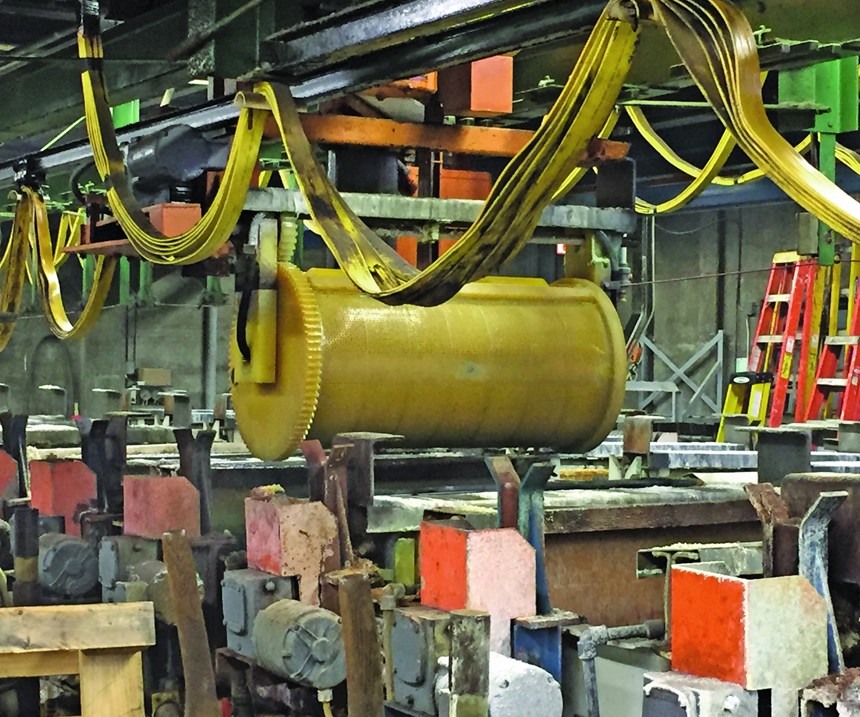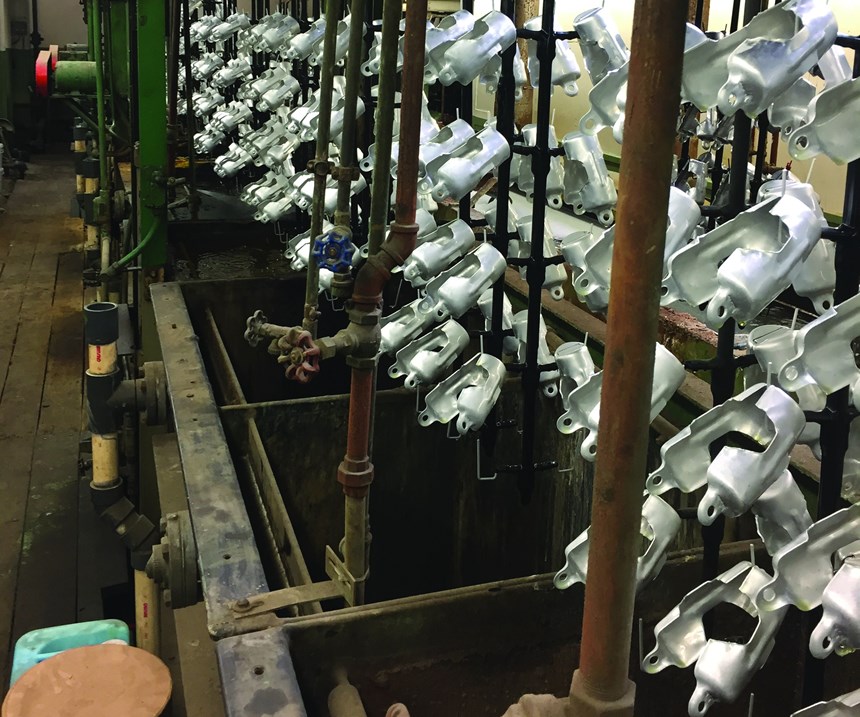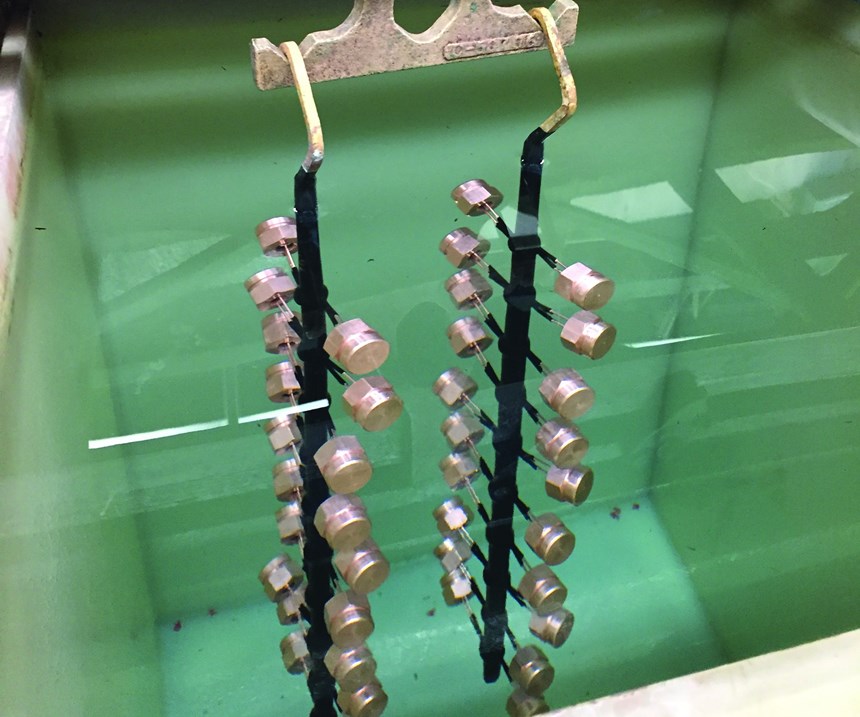Old School Ways for New Method Plating
Cadmium and die castings help a 86-year-old Massachusetts plating shop thrive.
For more than 86 years, there has been a Capalbo standing at the front door to greet visitors to New Method Plating in Worcester, Massachusetts.
First, there was Ralph Capalbo Sr., who took on a dare back in 1931 when he was just 17 years old and started his own plating operation using old, prohibition-era wine kegs. The young lad had innocently given business advice to a failing machine shop owner, who didn’t take kindly to the teenager’s lip and told him to “do it himself, if he was so dang smart.”
Ralph Sr., who passed away in 2006 at the wise age of 93, did just that, running a plating line from his parent’s basement until a few years later, when he hung his own shingle on Hammond Street, a sign that is still there today, in the same spot.
“Some things have never changed,” says Ralph Jr., who first hung parts for his dad when he was 12. He returned home after college (of course he would) and has worked for New Method ever since, helping build one of the first zinc die-casting plating lines in the Northeast and expanding the shop’s cadmium coating capabilities.
Today, Ralph Jr. is the company’s president and works alongside his sons Chris, vice president of operations, and Nick, vice president of facilities. New Method has distinguished itself in the aerospace and military coatings market with what it calls precision electroplating, specializing in cadmium.
“About 45 percent of our work is cadmium,” Ralph Jr. says, “but our biggest cadmium account is commercial, which is kind of unusual. The customer switched to zinc a few years ago, but lost some market share because of quality, so they have gone back to cadmium, because they wanted something that would last in a corrosive atmosphere.”
Precision Cadmium
The “precision cadmium” moniker comes from the reproducible tight tolerances that New Method says it can hit but that few shops will attempt. For example, the shop was approached by a supplier to the military industry to clean and cadmium-plate a forging. The project proved challenging because of tight timing requirements, and the numerous military and industrial specs that needed to be met. However, New Method, a Nadcap-accredited and ISO 9001:2000 AS9100-certified shop, was able to use its automated return-type plating lines to meet a tolerance of 0.0005-0.0008 inch of cadmium coating on 4140 alloy steel that had been previously heat treated offsite to 38-40 HRC.
Nick Capalbo says the plant’s high-capacity ovens allow for hydrogen embrittlement relief in pre- and post-plate baking, and the shop was able to deliver a high-volume order of 5,000 pieces in just three days.
In another example of precision work, New Method was asked to plate cadmium and yellow screws with strict quality requirements for an aerospace customer. The #8-32 by 0.401-inch screws, made from 8740 machined alloy steel and heat treated offsite to 36-40 HRC, were finished to a thickness tolerance of 0.0003-0.0006 inch, a project that included cleaning, plating, baking and chromating on an automated return-type barrel-plating line. The 115,000 screws were completed and delivered to the aerospace customer in three days.
“Having such strict processes, whether they be Nadcap or ISO, requires us to implement that quality company-wide,” says Chris Capalbo, who also is active on the national board of the National Association of Surface Finishers. “There are so many individual processes, but what ties it all together is that we have a great base of good, core, quality programs in place that moves everything forward.”
Many of those quality measures were installed by Ralph Sr. and then cemented into the company’s culture over the decades by Ralph Jr., who grew its capabilities in plating cadmium, copper, nickel, chrome and zinc.
Zinc Die Castings: A One-Shot Deal
It all probably started when Ralph Sr. installed the shop’s first automated cadmium return-type rack line during World War II and then a short time later added an automated nickel-chrome line that was then modified to handle plating of zinc die castings.
“Most other platers might shudder when they think of an automated zinc die-casting plating line, because you get one shot to get it right.” Ralph Jr. says. “Die casts are not something that are easily fixed, and within an hour, you can have more rejects than a normal manual line shop would have in a week.”
His son Chris says that ability to take on challenging projects with such tight tolerances and many requirements is what has made New Method stand out from the competition for almost 90 years, and also helped it earn a Products Finishing Top Shop distinction for the past several.
“Precision plating of zinc die castings is the second biggest thing we offer,” he says. “It’s a huge selling point for us, because you have to be right-on all the time, since you can’t strip these parts and start over. It’s a one-shot process.”
Ralph Jr. says it takes a quality operation to plate die castings, as well as experienced, trained craftsmen and technical staff, and New Method has this in its 19 employees.
“I’ve had other platers come up to me ask how I slept at night with an automatic plating line on zinc die castings,” he says. “If you don’t keep your chemistry up to snuff and stay on top of all your processes so that the adhesion is correct to begin with from the base up, then you’ll have problems. We pay very close attention to all of that.”
Nick agrees that it comes down to having a quality program in place, and following all guidelines and requirements closely, with no skimping.
NADCAP, ISO Certification
“We were operating the Nadcap way before many people even knew what Nadcap was,” Nick says. “We got our certification in 2003, and we’ve built on that and other certifications over time.”
Ralph Jr. says the stringent quality-control measures were put in place mostly for New Method’s defense and aerospace plating work, but that the same qualities go into every job the shop processes, including commercial ones.
“The commercial work is benefiting from all the Nadcap work we do, because they are getting the same quality and attention as the military and aerospace customers,” he says. “Every customer gets the same mindset.”
In the mid-1960s, New Method expanded its cadmium and die-cast plating lines by adding an automated nickel-chrome line, plus a faster cadmium rack line and a cadmium automatic barrel-plating line, too. In 1990, the shop added a computer-controlled, automatic-programmed nickel barrel-hoist line, which later was converted to an automated zinc barrel-plating line.
Soon after that, the shop began pursuing its ISO and Nadcap certifications, but Ralph Jr. says his father ran the shop like it was already under those requirements many decades before they were enacted.
“My father was the epitome of systems,” he says. “Everything had to be regimented, and there had to be contingencies in place. We always had to have a backup motor on the shelf or backup parts in case something broke. He thought that way all his life.”
The same mentality has been handed down. Nick is now in charge of making sure contingencies and backups plans are in place to keep the shop up and running under any circumstance.
“My dad’s system approach skipped a generation with me and went straight to Nick,” Ralph Jr. says with a chuckle.
Spare Parts to Prevent Downtimes
Nick admits he keeps spare parts for virtually everything, and this often has others giving him queried looks.
“They think I’m crazy, but we have to keep things up and running,” he says. “My grandfather had a good idea in that, because it does minimalize downtime. Motors, switches or anything that can break can turn into just an hour downtime instead of two days. That just makes perfect sense to me, because downtime costs money.”
Nearly all of New Method’s lines are automated, and most of them also are high-capacity and high-volume ones that run constantly. Most of the jobs that run on those lines are cadmium, however, and many regulators want use of cadmium to be phased out because it is considered toxic. Yet that decree doesn’t faze the Capalbos, who think cadmium will still be around for a long time.
“Everyone talks about a replacement, but then you talk to the Department of Defense people, and they will tell you ‘We have no intention of using anything else,’” Ralph Jr. says. “They want the good stuff because, even though the corrosion protection of the replacements is good, the contractors still want the ductility that cadmium offers them.”
Chris says that the military and defense work will be a staple of New Method’s business for years to come but that the shop is still flexible enough to handle any customer’s work that finds its way to Hammond Street.
“The work we have is very industry-driven, and it all depends on what the markets need,” he says. “We haven’t lost that many customers over the years, but the volume has changed. That just means we have to tap more markets. But we still have customers who have been making the same parts for a long, long time.”
Given that notion, the old method will continue to work the same at New Method.
For information on New Method Plating, call 505-754-2671 or visit newmethodplating.com.
Related Content
Looking to the Future of Finishing
Products Finishing takes a look at some of the ways the finishing industry is investing in workforce development and educational initiatives.
Read More40 Under 40: Class of 2023
Products Finishing's 40 under 40 program recognizes nominated individuals driving the surface industry forward. Meet the class of 2023.
Read MoreAkzoNobel Uses VR for Training Airline Apprentices
The virtual reality technology provides a paint booth and spray gun that enables trainees to work and master their skills without losing parts in the process.
Read MoreEducation, Networking, Insights at 2023 Parts Cleaning Conference
Attend the Parts Cleaning Conference in Cleveland, Ohio on April 19th, 2023, for a comprehensive look into all things having to do with cleaning technology.
Read MoreRead Next
A ‘Clean’ Agenda Offers Unique Presentations in Chicago
The 2024 Parts Cleaning Conference, co-located with the International Manufacturing Technology Show, includes presentations by several speakers who are new to the conference and topics that have not been covered in past editions of this event.
Read MoreEducation Bringing Cleaning to Machining
Debuting new speakers and cleaning technology content during this half-day workshop co-located with IMTS 2024.
Read MoreDelivering Increased Benefits to Greenhouse Films
Baystar's Borstar technology is helping customers deliver better, more reliable production methods to greenhouse agriculture.
Read More

























